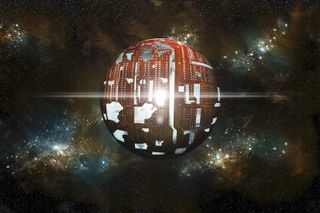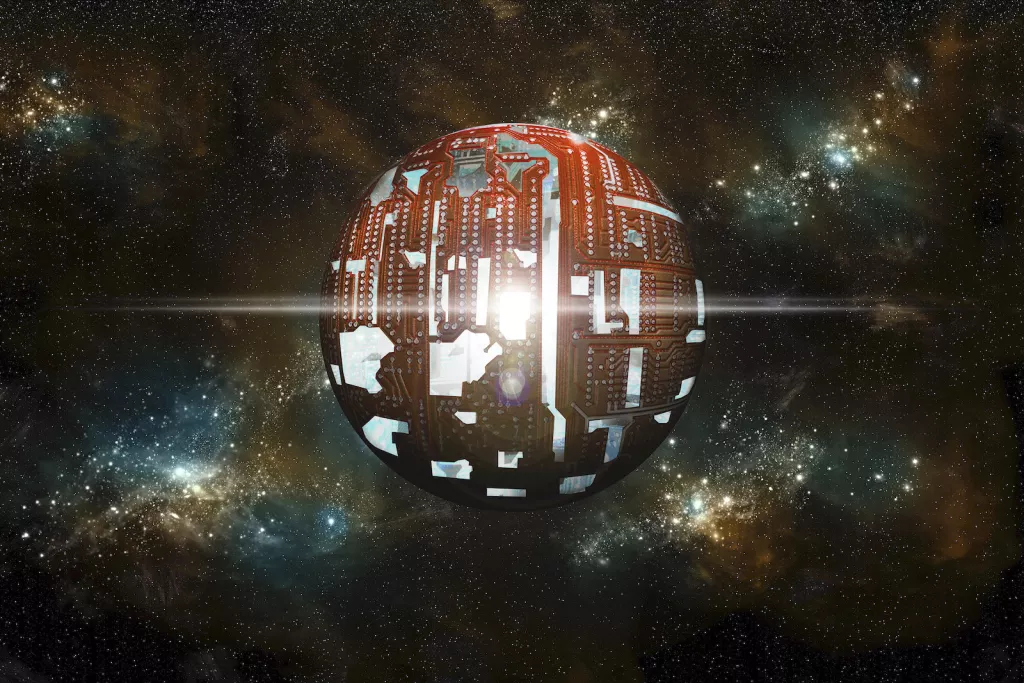
(Image credit: Marc Ward/Stocktrek Images/Getty)
Technologically-savvy aliens could be powering their society using a hypothetical megastructure called a Dyson sphere to harvest energy from a black hole. And the sphere might radiate in peculiar ways, allowing telescopes on Earth to discover the existence of intelligent beings elsewhere in the universe, a new study suggests.
A Dyson sphere is a speculative structure that would encircle a star with a tight formation of orbiting platforms in order to capture starlight and produce power, according to Live Science’s sister site Space.com. First proposed by theoretical physicist Freeman Dyson in 1960, the idea might be realized by a spacefaring extraterrestrial species who had spread out across their star system and therefore required ever-increasing amounts of energy.
During a coffee break, astronomer Tiger Yu-Yang Hsiao of National Tsing Hua University in Taiwan and his colleagues read a paper about Dyson spheres and began wondering if it were possible to build one around a black hole instead of a star.
“Black holes are one of the brightest objects in the sky,” Hsiao told Live Science.
While we normally think of them as being dark and all-consuming, black holes can radiate incredible amounts of energy, he added. Material often forms a disk as it falls into a black hole’s maw, much like water circling a drain.
As the gas and dust in this disk spin and bump against each other, they heat up through friction, sometimes to millions of degrees, producing light in the X-ray portion of the electromagnetic spectrum, Hsiao said. Colossal beams of energy can also shoot from a black hole’s poles.
Because black holes smoosh a gargantuan mass into a tiny area of space, they are smaller than stars and therefore potentially easier to encircle. A species that chooses to “build a Dyson sphere around a black hole can save a lot of material,” Hsiao said.
Aliens could place a large satellite in a stable orbit around a black hole and then collect X-ray energy using something akin to solar panels, study coauthor Tomotsugu Goto, also of National Tsing Hua University, told Live Science.
They might also build a ring-like structure around the black hole or totally surround it with platforms, much like in Freeman Dyson’s original proposal, Goto added, though each of these would be increasingly complex and challenging to construct.
In either case, a black hole could radiate up to 100,000 times more energy than a star like the sun, meaning that a celestial species would have a lot of power to work with, the researchers wrote in a paper published July 1 in the journal Monthly Notices of the Royal Astronomical Society.
After being absorbed and used, the energy from a cosmic object would have to be reradiated or else it would build up and eventually melt the Dyson sphere, as Dyson noted in his 1960 paper. This energy would be shifted to longer wavelengths, so a Dyson sphere around a black hole might give off an unexplainable energy signature in the ultraviolet or infrared, the researchers said.
Several instruments, including NASA’s space-based Wide-field Infrared Survey Explorer (WISE) and the Pan-STARRS telescope in Hawaii, have cataloged billions of objects during their detailed surveys of the night sky, Goto said. Should Dyson spheres around black holes actually exist, it’s possible that their telltale signs have already been recorded by such detectors, he added.
The team is now developing algorithms that can search through these databases and hunt for peculiar entities that might indicate Dyson spheres. “If it can really be found, I would feel ecstatic,” Hsiao said.
Such a search might be useful no matter what it uncovers, Macy Huston, a doctoral candidate in astronomy at The Pennsylvania State University who was not involved in the work, told Live Science. “Even if you’re not finding Dyson spheres, you’re probably going to find something interesting along the way,” they said.
Yet black holes provide distinct challenges to alien mega-engineers. The gravitational monsters tend to be less stable than stars in terms of their energy production, Huston said.
Whereas sunshine glows continuously, black holes often have bursts of activity followed by periods of quiet as they consume larger and smaller amounts of matter in their disks. An alien species might have to watch out for particularly large bursts that could destroy orbiting structures, Huston said.
But “if a species is looking for something more powerful than a star, this could be it,” they said.
Please remember we all have different opinions, Think Before You Speak or Write Something that is cruel to Others. After all, We are only Humans. Wishing you clear skies and wide eyes. To share your experiences or just leave a comment there is a area below. Read or listen.
We are the change the world has been waiting for!
Have you witnessed an unidentified flying object?
You are not alone. Whether you think UFOs are black projects, extraterrestrial craft, something else altogether, or just don’t know, again, you are not alone!
Unconditional love. The road we all get to walk. Unconditional love is like the sun.
WE ARE THE DISCLOSURE !~ WE HAVE NEVER BEEN ALONE
Love and Regards,
Thank You,
Nancy Thames
Source
Originally published in Live Science.


